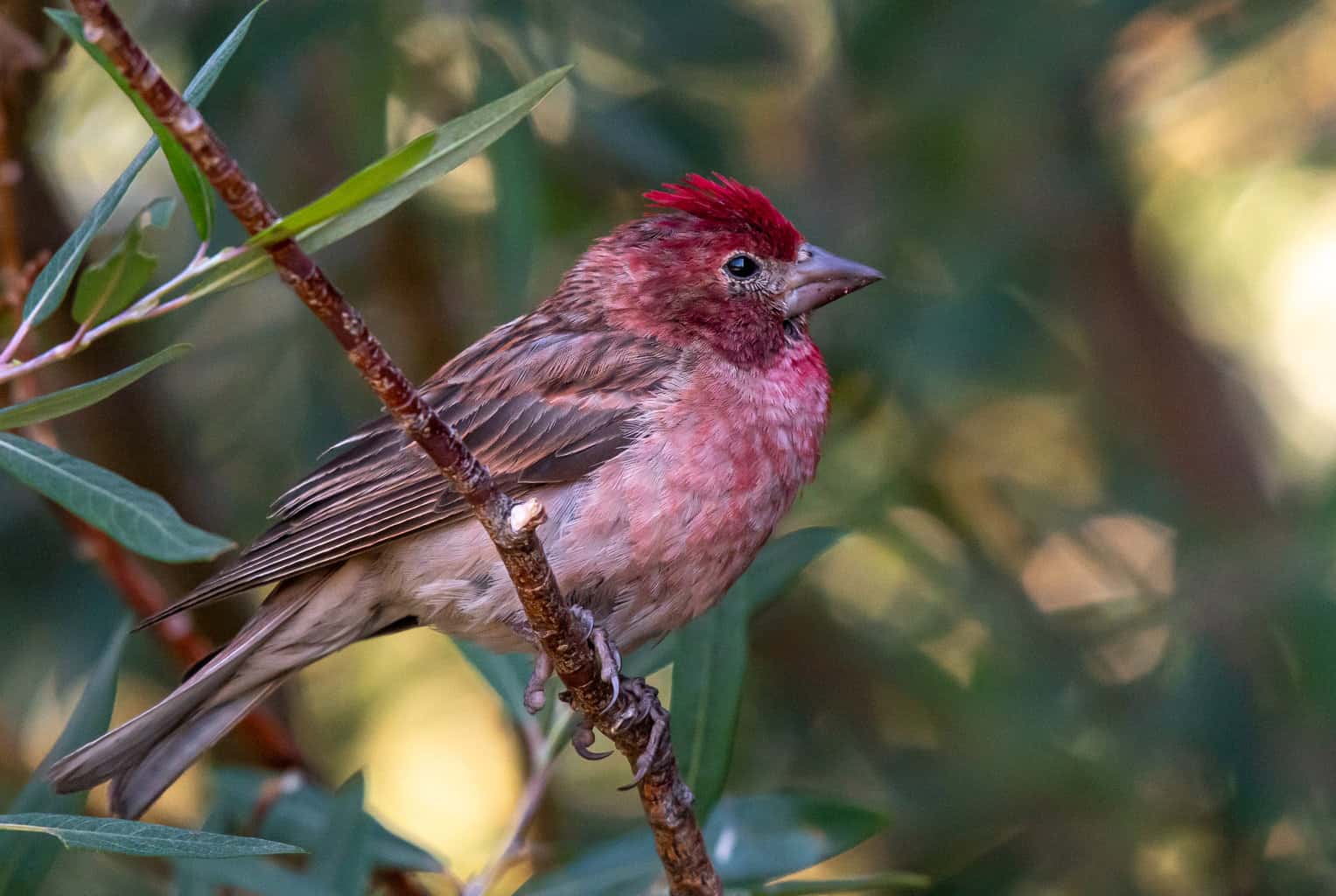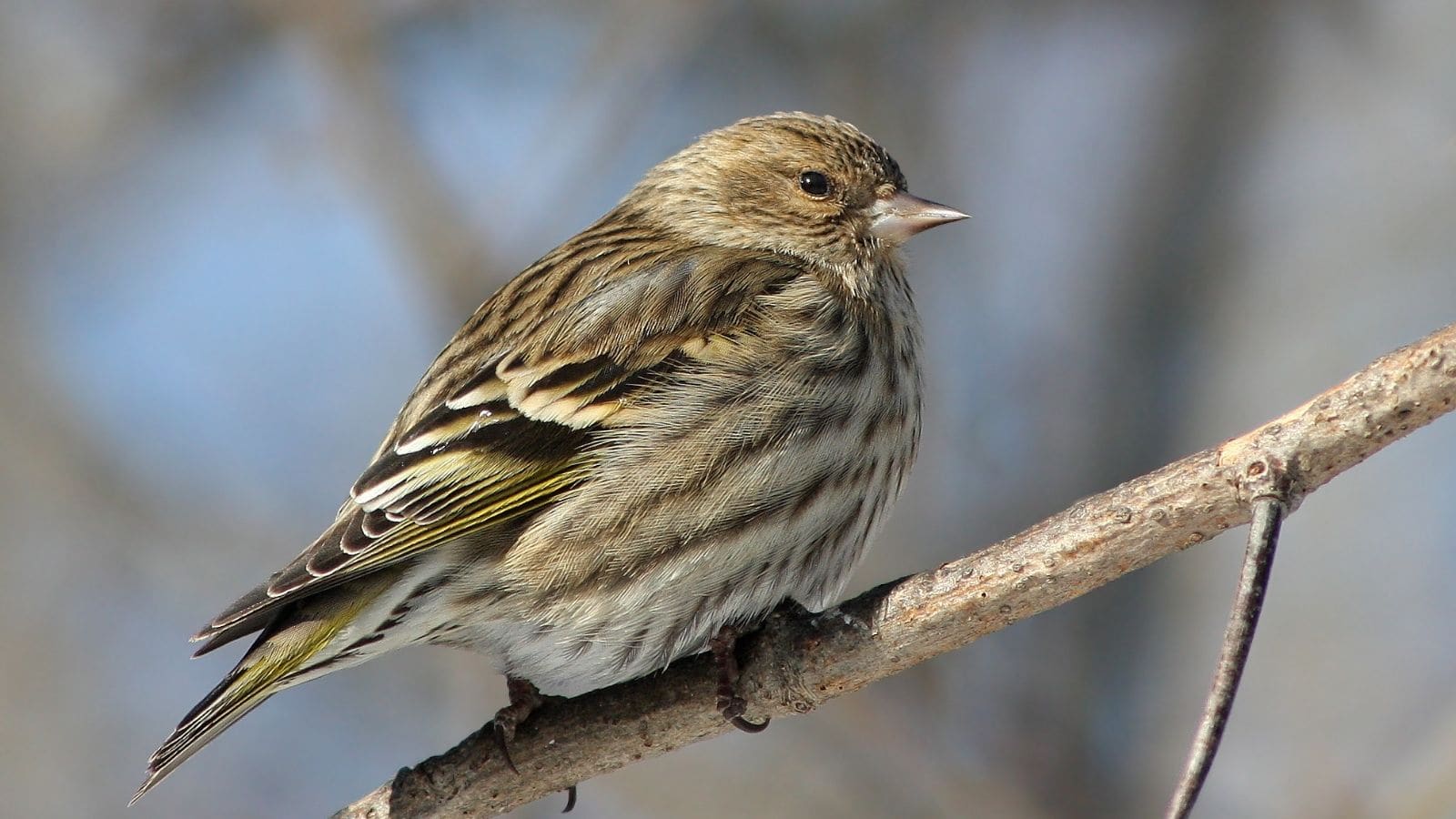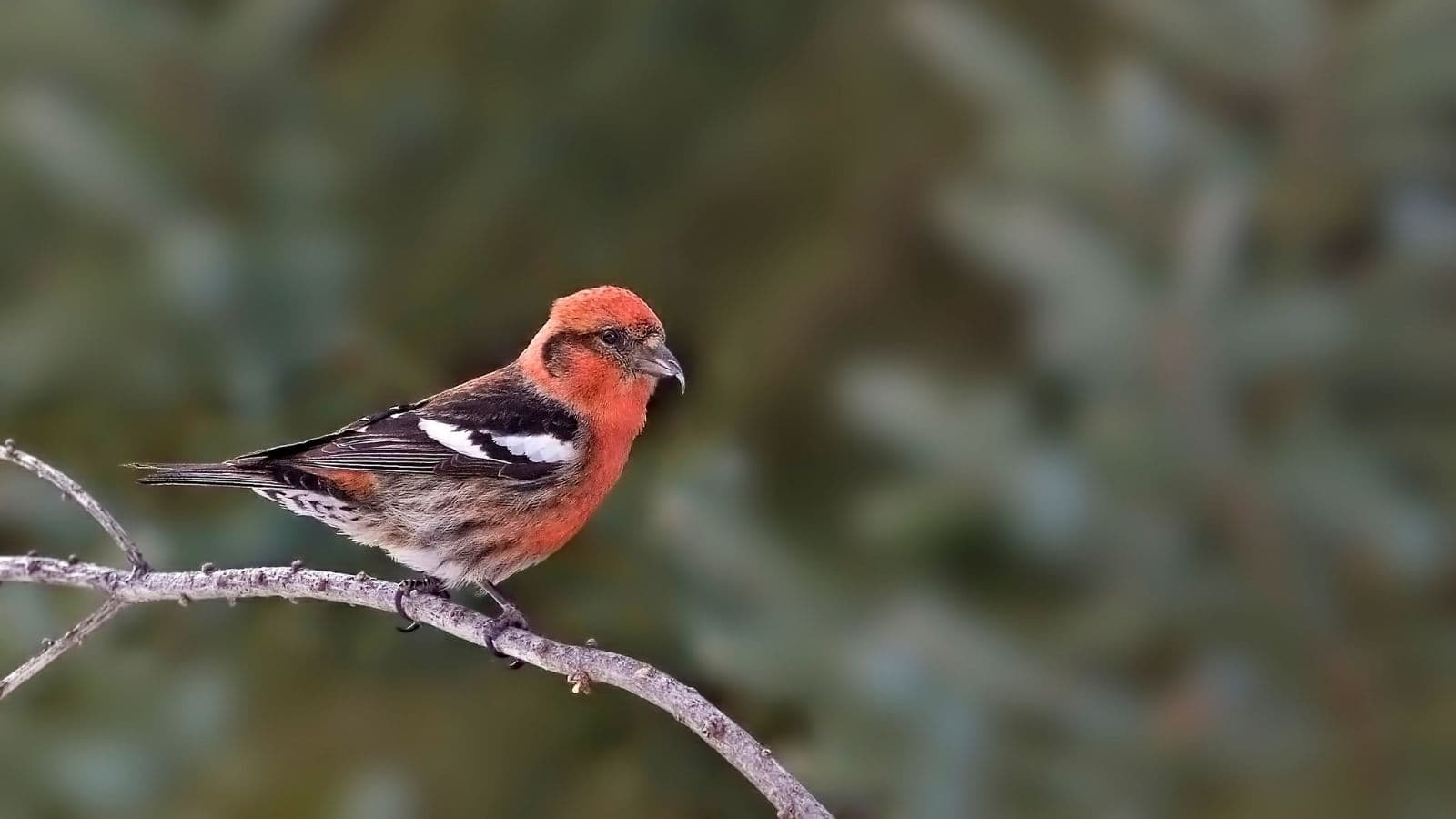In terms of its landscape, the Silver State is one of the most fascinating in the United States. There are its rivers, the Humboldt, the Colorado, and even tributaries of the Snake River.
There are also its mountains which reach heights of 13,000 feet and often create delightful contrasts of verdant forests set high above scorching desert plains.
This state of climatic contrasts with temperatures in parts soaring above 90 degrees in summer, and plummeting to below 10 degrees in winter is also home to an astounding number of avian species.
There are 491 bird species in Nevada. Here you will be able to read about the 15 finch species in Nevada that form a part of that collective. All so you will be able to identify them with ease the next time one hops on your window sill.
Black Rosy-Finch

- Scientific Name: Leucosticte atrata
- Length: 6.5 inches
- Weight: 2 – 3 ounces
- Wingspan: 13 inches
Mature members of this species have black foreheads while the upper half of their heads are gray. Their chests, upper, under surfaces, and wings, are covered in dark brown feathers which pale at their edges.
Those at their wings are paler than elsewhere and are lightly flushed with pink while those at their lower surfaces are more pink than brown.
Black rosy-finches tend to build their nests from moss and grass, placing them in cliff crevices or among large rocks. Females incubate their eggs although both parents feed the young.
Members of this species can be found in northeastern Nevada all year round, spreading south and southwest during winter.
They can also be found in Oregon, Idaho, Montana, and Wyoming, to the north, and Utah, to the east. Because their ranges radiate outwards during winter, they may also be found in Arizona and New Mexico during the season.
Gray-Crowned Rosy-Finch

- Scientific Name: Leucosticte tephrocotis
- Length: 5.5 – 6.3 inches
- Weight: 0.8 – 2 ounces
- Wingspan: 13 inches
Members of this mountain finch species wear a black mask that stands out against a gray background.
Their plumage at the chest, upper, and lower surfaces, is mostly dark brown. However, their wings are edged with pink, and also silver to a lesser degree, as are their tails which are long and forked.
Rather elusive, they prefer to live in the harsh tundra. However, they may be found in mountainous regions in California. Unlike certain finch species such as American goldfinches, they feed their young proteinous fare in the form of insects. This species is also partial to salt.
Gray-crowned rosy-finches can be found in northern Nevada in winter. They also visit Utah, Colorado, and Montana during the season.
Brambling

- Scientific Name: Fringilla montifringilla
- Length: 6 inches
- Weight: 0.8 – 1.02 ounces
- Wingspan: 10 inches
Members of this migratory finch species can be recognized by plumage which is predominantly brown shot through with orange and gray at the head and nape, and orange at the chest. They are also white at their upper and undersurfaces. Bramblings’ wing and tail feathers are dark although they may lighten to orange or even white at their tips and edges.
They are rarely seen in Nevada, but may however be spotted in winter on rare occasions. They have been known to visit Colorado although they are more commonly found in Alaska.
Cassin’s Finch

- Scientific Name: Haemorhous cassinii
- Length: 6 inches
- Weight: 0.8 – 1.2 ounces
- Wingspan: 10 – 11 inches
Adult male members of this species have a dusky red tufted crown. Their heads, on the other hand, are a more muted raspberry blended in with brown. That reddish-pink hue extends to a lightly striated chest. Their wing feathers on the other hand are brown, tipped with gray at the edges.
Females are similarly colored but however, lack the red tufted crown and pink coloring of the males. Their chests are also more heavily striated.
Cassin’s finches can be found throughout Nevada all year long with the exception of its southern tip. They are also found in neighboring California and Utah.
House Finch

- Scientific Name: Haemorhous mexicanus
- Length: 5 – 6 inches
- Weight: 0.6 – 0.9 ounces
- Wingspan: 8 – 10 inches
Males of this intrepid, hardy species are generally a mild brown with blurred striations at the chest and undersurface. Their key distinguishing feature, however, is the presence of red pigmentation at the head and chest.
Females lack that red coloring and are brown overall with striations at the chest, as well.
House finches can be found throughout the state of Nevada, all year long, as is the case with most states in North America (Florida and Texas are the only exceptions).
Purple Finch

- Scientific Name: Haemorhous purpureus
- Length: 4.7 – 6.3 inches
- Weight: 0.63 – 1.10 ounces
- Wingspan: 10 inches
Considered lookalikes of their house finch relatives, purple finches can nevertheless be distinguished by certain key features.
The first of these are their rather rounded heads which are completely covered in raspberry red in males compared to the sharper red of house finches.
The second is the presence of bolder striations on the chests of female purple finches as opposed to the somewhat blurred stripes on the chests of female house finches.
Purple finches are also generally more slender in form compared to their relatives.
Although they are found all year round in neighboring California, Nevada is not part of their range. They prefer to winter further east from the eastern extremes of South Dakota, Nebraska, Kansas, and Oklahoma.
American Goldfinch

- Scientific Name: Spinus tristis
- Length: 5.5 inches
- Weight: 0.4 – 0.7 ounces
- Wingspan: 8 – 9 inches
Males of this species are covered in beautiful golden feathers with hints of white, which are all the more highlighted owing to their black crowns, and black wings streaked with white. Their undertail coverts are also white. Females are generally a more muted yellow color with darker beaks as opposed to the orange beaks of their male counterparts.
American goldfinches can be found in Nevada’s northern half all year round. They prefer to winter in its southern half. They are generally found all year long throughout the United States to the north of New Mexico, and winter in regions to the south. California’s southern Pacific Coast is the only exception where they can be found all year round in a southern region.
Lawrence’s Goldfinch

- Scientific Name: Spinus lawrencei
- Length: 5.5 inches
- Weight: 0.4 – 0.7 ounces
- Wingspan: 8 – 9 inches
Males of this species are covered in a beautiful cool gray against which their black face masks form a striking contrast.
Unlike their American and lesser goldfinch cousins, the only gold on their plumage is found on the chest and wings. Their tricolored wings are also black and white in an enchanting pattern while their undertail coverts are mostly a pristine white at the center.
Females are also gray. Although they too have a splash of gold at the wings and chest, it is more muted than that of male Lawrence’s goldfinches.
This species migrates through the extreme south of Nevada and may also be found in the same region in winter.
However, they are mainly found in California and may fly southwards to the peninsula during winter. They may also migrate to Arizona or even New Mexico.
Lesser Goldfinch

- Scientific Name: Spinus psaltria
- Length: 3.5 – 5 inches
- Weight: 0.3 – 0.4 ounces
- Wingspan: 6 – 8 inches
One of Nevada’s favorite bird species, lesser goldfinches are relatives of the equally enchanting American and Lawrence’s goldfinches.
Males are covered in green or black at their upper surfaces, they also have black wings marked with white wing bars. Their undersurfaces, however, are golden yellow. Unlike American goldfinches, that bold summery plumage remains that way all year round.
Females as well as youngsters are a buff yellow at their upper surfaces; their yellow undersurfaces and wings are less vibrant compared to adult males’.
These talkative, tiny finches are rather partial to nyjer seeds at bird feeders and sunflower seeds in the wild.
Lesser goldfinches breed in eastern, southern, and western Nevada. They are, however, absent from its central part.
Evening Grosbeak

- Scientific Name: Hesperiphona vespertina
- Length: 6 – 9 inches
- Weight: 1.4 – 3 ounces
- Wingspan: 12 – 14 inches
Evening grosbeaks can be found in northwestern Nevada and its east. However, they are not regular visitors to the state. They can be mainly found in southern Canada to the north as well as Washington, Oregon, Idaho, Montana, Wyoming, and north central Utah.
These large finches can be recognized by their dark brown heads interrupted by a bold yellow stripe above the eyes in males. Their upper and lower surfaces are mustard-colored, while their wings are black with a large white wedge at the center of each.
Female evening grosbeaks are gray for the most part with wings that have prominent white markings. The only yellow in their plumage is commonly found at the neck.
Pine Grosbeak

- Scientific Name: Pinicola enucleator
- Length: 9 inches
- Weight: 2 – 3 ounces
- Wingspan: 13 inches
This species can be found in Nevada’s extreme northeast. It can also be found in central Utah, central Colorado, and eastern Arizona.
Male pine grosbeaks are large red finches with barring in red, brown, and black beneath the nape. Their wing feathers are also a blend of black and gray with whitening at the tips and edges.
Female pine grosbeaks, on the other hand, are gray with bronze heads. The species enjoys a mostly fruit-based diet. Members may also head south if there is insufficient food in their northern range which includes Alaska and Canada.
Pine grosbeaks are capable of tolerating human proximity to a surprising degree.
Pine Siskin

- Scientific Name: Spinus pinus
- Length: 4 – 5.5 inches
- Weight: 0.40 – 0.60 ounces
- Wingspan: 7 – 9 inches
Pine siskins are small finches covered in plumage streaked with brown. Their striations are rather heavy at the head. At the chest and abdomen, those stripes become sparser so that they stand out against a white background. Their legs are a pale brown while their beaks are rather tapered and a metallic brown. Hints of yellow can be found beneath their wings and their tails.
These finches which closely resemble sparrows can be found in eastern Nevada all year long. They can be found throughout the western United States and fly eastwards during winter.
Common Redpoll

- Scientific Name: Acanthis flammea
- Length: 4.5 – 5.5 inches
- Weight: 1.12 ounces
- Wingspan: 8 – 9 inches
This little winter finch is covered in plumage patterned with brown striations against white. It also wears a little red cap at its crown while its less densely striated chest may show a flush of pink if it is a male, and none if it is a female.
Its wings are also the same brown with white wing bars.
This species known for being rather active, breeds in the far north, in Canada where it also spends most of its time, including winter.
However, it may spend the season in the United States in which case it may be found in northeastern Nevada.
Red Crossbill

- Scientific Name: Loxia curvirostra
- Length: 7.5 inches
- Weight: 2 ounces
- Wingspan: 12 inches
Red crossbills are rather robust finches whose males are covered in a reddish copper hue with varying degrees of brown. Female members of the species are gray with bronze at the head and chest. The species is also known for its dark beak with one mandible crossed over the other.
These savvy birds tend to ensure their breeding coincides with an abundance of cones and nest in conifers.
Red crossbills live in northeastern Nevada as well as its western extremity, throughout the year. They also live in the western United States, Canada, and southern Alaska.
White-Winged Crossbill

- Scientific Name: Loxia leucoptera
- Length: 5.7 – 6.7 inches
- Weight: 0.9 – 1.40 ounces
- Wingspan: 11 inches
These finches have characteristic crossed mandibles and dark wings with white wing bars.
Males are a beautiful red, while females are heavily striated with brown at the head and chest, with splashes of bronze at the breast and head.
Like red crossbills, members of the species time their nesting season to coincide with the abundance of their favorite cones. Hence they are not averse to nesting right in the middle of winter.
Although they live all year round in Canada they may fly further south to the United States during winter.
Nevada’s northeast is part of that range which dips as far south as northern New Mexico.
White-winged crossbills are rather fond of salt, and like most finches are rather partial to conifer seeds. They also supplement their diet with berries, buds, and insects.
In addition to being a source of food, conifers are also a source of shelter; white-winged crossbills build their nests in them using bark, grass, lichen, moss, and twigs.
Conclusion
From mountain rosy-finches to goldfinches, and crossbills, Nevada is home to a greater variety of passerines than most states.
Included in that list are the rather rare but no less enchanting lesser goldfinch, the salt-loving white-winged crossbill, and the large mustard-colored evening grosbeak.
Also included are the rather sedate pine grosbeak which is pretty unique in its ability to often sit still while curious bird watchers pass by.
And they’re part of a large family of over 400 species: proof that the Sagebrush State is indeed a paradise for birds and bird watchers alike.

